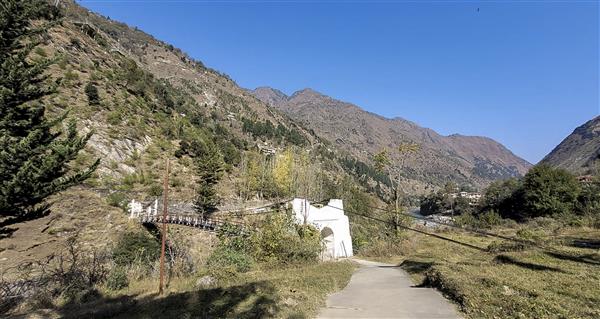Kashmir village along Line of Control hopes divided bridge will bridge the divide
Date:- 02 Nov 2022

Many residents of Tithwal village appeal that the crossing point over Kishanganga river be again reopened to allow passage and ‘connect hearts’ of people on both sides
A neat white line drawn in the middle of a suspension bridge that sits right on the Line of Control separates the border village of India’s Tithwal and Pakistan-occupied Kashmir (PoK). The bridge has seen wars and tumultuous phases of history in the heavily militarised region.
With a ceasefire understanding reached between India and Pakistan since February last year, resulting in peace and tranquillity here, many residents of this Jammu and Kashmir village are now appealing that the crossing point over the Kishanganga river be again reopened to allow passage and “connect hearts” of people on both sides.
The bridge, constructed in 1931 by the then princely state of Jammu and Kashmir, has seen the bloody Partition in 1947 and the tragic human migrations that accompanied it, witnessed wars between India and Pakistan and see-sawing relationship between the two countries over the last 75 years.
The 160-ft-long wooden suspension bridge on Kishanganga—called Neelum in Pakistan—is one of the four crossing points on the LoC.
Some of the locals also recalled the poignant fictional story ‘Titwal ka Kutta’ by noted author Saadat Hasan Manto describing the “pains of Partition”.
The bridge, officially called the Chilehana Tithwal Crossing Point (CTCP), is heavily guarded on both sides.
Since the ceasefire understanding last year, “curiosity of people has grown” from both sides to know about each other, Indian Army officials said.
Zameer Ahmad, 55, the Numberdar of Tithwal village, located 175 km from Srinagar, told PTI that “the village on the PoK side across the river has become a tourist point and people come there from Muzaffarabad, Lahore and Rawalpindi to see the LoC and life in India”.
He pointed to a restaurant perched on the edge of a hill with a Pakistani flag on it and a group of people curiously looking towards Tithwal from a street built on a higher elevation in the hills which face the Indian village.
India and Pakistan are “brothers, separated at birth”. Now, the two sides should try to achieve lasting peace “through talks and without any fight”, Ahmad said.
“After the Partition, the land got divided overnight but families were living on both sides of Kishanganga. Many children got separated from their parents, others lost their relatives in wars between the two sides. But they yearn to go back to their ancestral place to at least see it or reunite with separated family members,” he said.
“Now, with the ceasefire since early last year, resulting in peace in the area, the crossing point at Tithwal should be reopened for people on both sides with proper permit,” Ahmad said.
Army sources said that ceasefire violations had impacted regular life in Tithwal “enormously”. The locals couldn’t move freely during any time of the day and schools weren’t regular, they said.
Since the ceasefire understanding, there has been a “marked improvement in the routine activities”, a source said.
The old bridge was destroyed by Kabaili raiders from the Pakistan side in 1948. It was rebuilt jointly by India and Pakistan in 1988, official sources said.
“Citizens from both sides were allowed to move across the bridge on every second and fourth Thursdays on a special permit. This move has been stopped post August 5, 2019. The special permit was valid for a fortnight,” an Army source told PTI.
Civilians who have since then inadvertently wandered on to the other side have been repatriated as humanitarian gestures.
A young boy from the other side had been repatriated on September 25, the last such repatriation from the Indian side, the source said.
Tithwal village with a population is 1,270 is the second last village along the LoC, Simari being the last, and is located between the LoC and the AIOS (anti-inflitration obstacle system), a fencing layer of concertina wires.
The village is located 82 km from Kupwara town. Tourists require permission from the civil administration to visit the village.
Ajaz Ahmad, member of a committee that is working to rebuild an old temple dedicated to goddess Sharada in Tithwal village, appealed to both the Indian and Pakistani governments to allow opening of the Tithwal crossing point so that pilgrims can easily go to the ancient Sharada Peeth located in PoK after reaching the Tithwal temple.
Signs of patriotism are obvious around the bridge with a huge tricolour hoisted on a towering flagpole and a small wooden gate near the river, which leads to the bridge, painted in a tricolour theme with ‘Mera Desh Mahan’ inscribed on both sides of it, but signs of hope for achieving lasting peace are also there.
Near the bridge there is also a ‘Sarva Dharm Sthal’ and an open gate—barely a few metres from the iron gate that leads to the Tithwal bridge—carries an inscription on top that reads “Bridging the Divide for Peace and Prosperity Tithwal”.
Also, sweets are exchanged between the two sides on Independence Day, Republic Day and New Year’s Day, as also on Eid and Diwali festivals.
Ahmad calls the Tithwal crossing point a “bridge of hope (‘aman ki umeed’)” and, said though the bridge itself is divided, it may help bridge the divide between the two neighbours.
Courtesy: The Tribune India : 1st Nov , 2022


